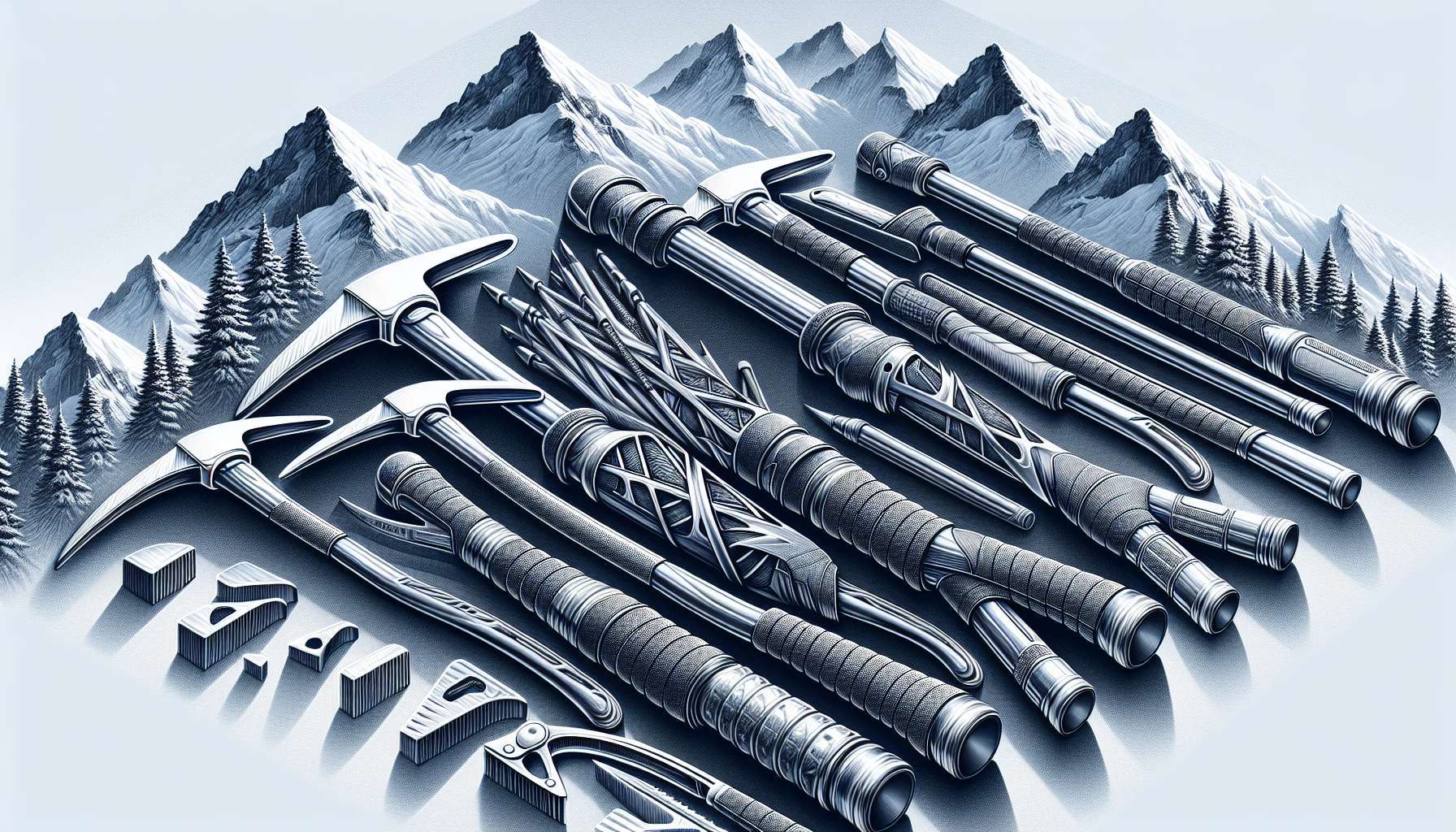The Comprehensive Guide to Ice Axes
When it comes to exploring icy terrains, scaling frozen peaks, or navigating treacherous glaciers, one tool stands out as essential for mountaineers and ice climbers alike the ice axe. This versatile and iconic piece of equipment has a rich history and a wide range of uses in the world of winter sports and outdoor adventure. In this comprehensive guide, we will delve deep into the world of ice axes, exploring their evolution, functions, types, and much more. So grab your crampons and let’s embark on a journey to uncover the secrets of the ice axe!
The Evolution of Ice Axes
Ice axes have been an indispensable tool for mountaineers for centuries, evolving from simple wooden sticks to the high-tech tools we see today. The earliest forms of ice axes were nothing more than stout sticks with a sharpened metal tip, used for stability on icy terrain. Over time, these primitive tools were refined and improved upon, with the addition of a pick on one end for self-arrest in case of a slip, and a adze on the other for cutting steps in the ice.
In the 19th century, with the advent of alpine climbing as a sport, ice axes underwent a major transformation. Lightweight materials such as aluminum and titanium were introduced, making ice axes easier to carry and more durable. The design of the ice axe also evolved, with curved shafts and ergonomic grips being developed to improve performance and reduce fatigue.
Today, ice axes come in a variety of shapes and sizes, each designed for specific types of ice climbing and mountaineering. From classic mountaineering axes to technical ice tools, there is a wide range of options available to suit every climber’s needs and preferences.
The Anatomy of an Ice Axe
Before we delve into the different types of ice axes, it’s important to understand the basic components that make up this essential tool. An ice axe typically consists of five main parts:

- Pick: The sharp metal point at the end of the ice axe that is used to grip the ice and provide stability.
- Adze: The flat, blade-like attachment on the opposite end of the pick, used for cutting steps in the ice or snow.
- Shaft: The long, straight or curved handle of the ice axe that provides leverage and control.
- Grip: The part of the shaft that is held by the climber, usually made of rubber or plastic for a comfortable and secure hold.
- Leash: A wrist strap or leash that attaches the ice axe to the climber’s wrist, preventing accidental drops.
Understanding the anatomy of an ice axe is crucial for proper usage and safety while climbing in icy conditions. Each component plays a vital role in the functionality and performance of the ice axe, so it’s important to choose the right tool for the job.
Types of Ice Axes
When it comes to choosing an ice axe, there are several factors to consider, including the type of climbing you will be doing, the terrain you will be navigating, and your personal preferences. Here are some of the most common types of ice axes:
Mountaineering Ice Axes
Mountaineering ice axes are versatile tools designed for general mountaineering and glacier travel. They typically have a straight shaft, a moderate-sized pick, and a small adze for basic snow and ice work. Mountaineering ice axes are ideal for climbers who need a reliable tool for a variety of alpine terrain.
Technical Ice Tools
Technical ice tools are specialized ice axes designed for steep ice climbing and mixed climbing. They feature a curved shaft, a aggressive pick, and a larger adze for cutting steps in hard ice. Technical ice tools provide maximum performance and precision on challenging ice routes.
Classic Ice Axes
Classic ice axes are a hybrid between mountaineering ice axes and technical ice tools, offering a balance of versatility and performance. They are great for climbers who want a single tool that can handle a variety of terrain and conditions.
Alpine Ice Axes
Alpine ice axes are lightweight and minimalist ice axes designed for fast and light alpine climbing. They feature a compact design, a small pick, and a narrow adze for cutting steps in snow and ice. Alpine ice axes are perfect for alpinists who value speed and efficiency on technical routes.
Choosing the Right Ice Axe
With so many options available, choosing the right ice axe can be a daunting task. Here are some factors to consider when selecting an ice axe:
Length
The length of the ice axe shaft should be proportional to your height and the type of climbing you will be doing. A longer shaft provides more leverage and stability on steep terrain, while a shorter shaft is more maneuverable in tight spaces.
Pick Type
There are two main types of picks: modular picks that can be replaced for different types of climbing, and fixed picks that are integrated into the ice axe. Choose a pick that suits your climbing style and the type of terrain you will be encountering.
Shaft Material
Ice axe shafts are typically made of aluminum, titanium, or carbon fiber. Aluminum shafts are durable and affordable, titanium shafts are lightweight and strong, and carbon fiber shafts are ultra-lightweight and rigid. Consider the trade-offs between weight, durability, and cost when selecting a shaft material.
Adze Size
The size of the adze should match the type of terrain you will be climbing. A larger adze is more efficient for chopping steps in hard ice, while a smaller adze is lighter and more maneuverable on technical routes.
Weight
The weight of the ice axe is an important consideration, especially for long climbs or alpine ascents. Choose a lightweight ice axe that won’t weigh you down but still offers the performance and durability you need.
Expert Opinions
We reached out to professional mountaineer and ice climber, Emily Harrington, for her insights on the importance of choosing the right ice axe for your climbing adventures. According to Harrington, “The ice axe is your lifeline on the mountain, so it’s crucial to have a tool that you trust and feel comfortable using in any situation. Take the time to test different ice axes and find one that fits your style and skill level.”
Common Misconceptions
One common misconception about ice axes is that they are only used for climbing up icy slopes. In reality, ice axes have a wide range of uses, including self-arrest, cutting steps, building anchors, and even as a makeshift walking stick on rough terrain. Understanding the versatility of the ice axe is key to maximizing its potential in the mountains.
Comparative Analysis
When comparing different types of ice axes, it’s important to consider their intended use, design features, and performance capabilities. While technical ice tools offer superior performance on steep ice, they may be overkill for simple glacier travel. On the other hand, mountaineering ice axes are versatile and reliable but may lack the precision needed for technical ice climbing. By carefully evaluating your climbing objectives and skill level, you can choose the ice axe that best suits your needs.
FAQs
Q: Can I use an ice axe for self-arrest on steep terrain?
A: Yes, ice axes are designed for self-arrest in case of a slip or fall on icy slopes. By planting the pick into the snow and rolling onto your stomach, you can quickly stop a slide and prevent a dangerous fall.
Q: How do I maintain my ice axe?
A: Regular maintenance of your ice axe is essential for ensuring its durability and performance. Keep the pick sharp, clean off any dirt or debris, and store the ice axe in a dry, well-ventilated area to prevent rust and corrosion.
To Wrap Things Up
Ice axes are more than just tools for climbing they are symbols of adventure, perseverance, and skill in the mountains. Whether you’re a seasoned mountaineer or a novice ice climber, choosing the right ice axe can make all the difference in your outdoor pursuits. By understanding the history, anatomy, and types of ice axes, you can equip yourself with the knowledge and tools needed to conquer icy summits and frozen landscapes. So next time you head out into the winter wilderness, make sure to pack your ice axe and embrace the challenges that await!




